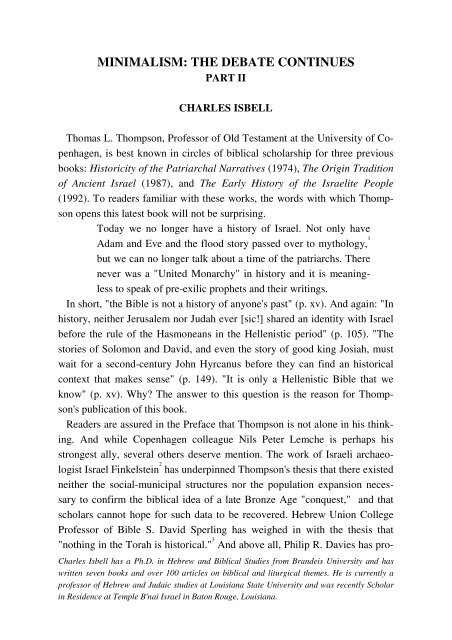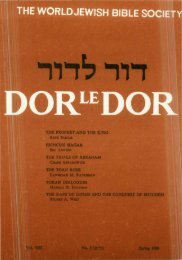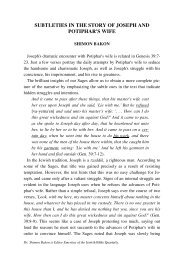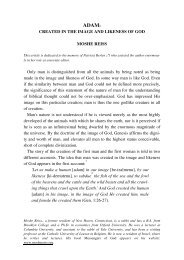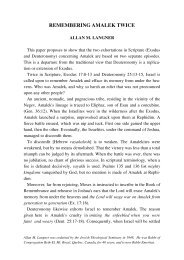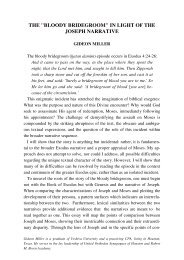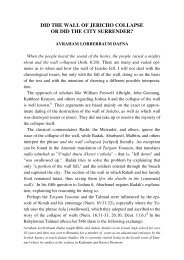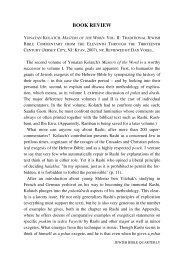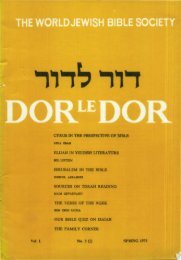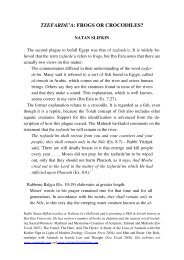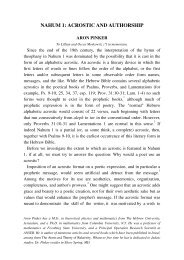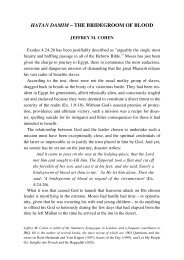Minimalism: The Debate Continues: Part II - Jewish Bible Quarterly
Minimalism: The Debate Continues: Part II - Jewish Bible Quarterly
Minimalism: The Debate Continues: Part II - Jewish Bible Quarterly
You also want an ePaper? Increase the reach of your titles
YUMPU automatically turns print PDFs into web optimized ePapers that Google loves.
MINIMALISM: THE DEBATE CONTINUES<br />
PART <strong>II</strong><br />
CHARLES ISBELL<br />
Thomas L. Thompson, Professor of Old Testament at the University of Copenhagen,<br />
is best known in circles of biblical scholarship for three previous<br />
books: Historicity of the Patriarchal Narratives (1974), <strong>The</strong> Origin Tradition<br />
of Ancient Israel (1987), and <strong>The</strong> Early History of the Israelite People<br />
(1992). To readers familiar with these works, the words with which Thompson<br />
opens this latest book will not be surprising.<br />
Today we no longer have a history of Israel. Not only have<br />
Adam and Eve and the flood story passed over to mythology, 1<br />
but we can no longer talk about a time of the patriarchs. <strong>The</strong>re<br />
never was a "United Monarchy" in history and it is meaningless<br />
to speak of pre-exilic prophets and their writings.<br />
In short, "the <strong>Bible</strong> is not a history of anyone's past" (p. xv). And again: "In<br />
history, neither Jerusalem nor Judah ever [sic!] shared an identity with Israel<br />
before the rule of the Hasmoneans in the Hellenistic period" (p. 105). "<strong>The</strong><br />
stories of Solomon and David, and even the story of good king Josiah, must<br />
wait for a second-century John Hyrcanus before they can find an historical<br />
context that makes sense" (p. 149). "It is only a Hellenistic <strong>Bible</strong> that we<br />
know" (p. xv). Why? <strong>The</strong> answer to this question is the reason for Thompson's<br />
publication of this book.<br />
Readers are assured in the Preface that Thompson is not alone in his thinking.<br />
And while Copenhagen colleague Nils Peter Lemche is perhaps his<br />
strongest ally, several others deserve mention. <strong>The</strong> work of Israeli archaeologist<br />
Israel Finkelstein 2<br />
has underpinned Thompson's thesis that there existed<br />
neither the social-municipal structures nor the population expansion necessary<br />
to confirm the biblical idea of a late Bronze Age "conquest," and that<br />
scholars cannot hope for such data to be recovered. Hebrew Union College<br />
Professor of <strong>Bible</strong> S. David Sperling has weighed in with the thesis that<br />
"nothing in the Torah is historical." 3<br />
And above all, Philip R. Davies has pro-<br />
Charles Isbell has a Ph.D. in Hebrew and Biblical Studies from Brandeis University and has<br />
written seven books and over 100 articles on biblical and liturgical themes. He is currently a<br />
professor of Hebrew and Judaic studies at Louisiana State University and was recently Scholar<br />
in Residence at Temple B'nai Israel in Baton Rouge, Louisiana.
CHARLES ISBELL<br />
vided not only weighty scholarly support for the theses of Thompson but has<br />
also edited (through JSOT Press) a raft of impressive books and articles written<br />
by adherents to this new school of thought.<br />
It is not difficult to summarize the basic thesis of Thompson. For him, if it<br />
were not for archaeology and the physical artifacts it recovers, there would be<br />
no history of the ancient Near East. Reading archaeology through the lens of<br />
the <strong>Bible</strong> yields a distorted and inaccurate picture because it assumes the basic<br />
historicity of the biblical narratives, and so the process should work the<br />
other way. <strong>The</strong> ideology of the <strong>Bible</strong> must be read through the unbiased and<br />
objective lens of archaeology. We may find that once in a while the <strong>Bible</strong><br />
luckily gets something correct, but archaeology will receive the last word on<br />
every point at which the two disagree. 4<br />
Two things in particular characterize the work of Thompson. First, he has a<br />
penchant not only for dismissing in cavalier fashion anyone who might disagree<br />
with him either at present or in the past, but also for impugning their personal<br />
integrity as well. Thus he speaks of a 1960s scholarly theory about Nuzi<br />
parallels to patriarchal customs (now widely believed to be incorrect) not<br />
as a reconstruction that has been proven tenuous in the light of evidence<br />
which had not been available when the original proponents (serious scholars<br />
like E. A. Speiser and C. H. Gordon among them!) first proposed the idea,<br />
but as "a thinly veiled fabrication" (p. xii). Again, tenets of the "Amorite hypothesis,"<br />
now believed by Thompson to be incorrect, had never been anything<br />
more than "arbitrary and wilful [sic!] . . . careless assertions" (p. xii).<br />
In other words, those whose positions Thompson denies were all guilty of<br />
allowing their personal ideologies to color the way in which they interpret the<br />
<strong>Bible</strong>. And they were sometimes blatantly unethical: "At least one [Nuzi]<br />
contract had been mistranslated with the purpose of creating a parallel with<br />
the <strong>Bible</strong>" (p. xii).<br />
Other Thompson hallmarks are the tossing off of self-evident statements as<br />
if they were completely new thoughts and the ascribing to "all scholars" positions<br />
that few if any of us hold. For instance:<br />
A. "We have good reason to argue that the book [of Psalms] as a whole as<br />
it now exists in the <strong>Bible</strong> was understood as a book of songs of praise" (p.<br />
238). Well, the Hebrew title of the book is Tehillim [Praises], so surely no<br />
serious scholar would assume that such a statement was newsworthy. Yet<br />
JEWISH BIBLE QUARTERLY
MINIMALISM: THE DEBATE CONTINUES: PART <strong>II</strong><br />
Thompson uses this simple datum, surely known to every first-semester student<br />
of <strong>Bible</strong>, to insist that these songs were not sung as a reflection of an<br />
early cultus (ninth or eighth century BCE for example), and further that they<br />
cannot be "the voice of a temple community that so many scholars once imagined<br />
to have existed in the fictional Jerusalem of Ezra or Nehemiah of the<br />
Persian period" (p. 238). <strong>The</strong>n, even though there is no connection between a<br />
simple statement of fact well known to everyone and the conclusion drawn<br />
from it by Thompson, we are assured that these songs are "not of an older<br />
and earlier Israel," but tell us only about the "true Israel" that did not come<br />
into existence until Hellenistic (or better Hasmonean) times (see pp. 238-9).<br />
B. "A biblical narrative reflects the historical context of its writing rather<br />
than the more distant past of its referent" (pp. 66-67). Thompson gives no<br />
reference to any particular scholar who is guilty of forgetting this elementary<br />
dictum, as he declines to tell us who forged a Nuzi contract, but solemnly<br />
assures us that "archaeological research of the past century" has repeatedly<br />
done so. His repetition of the dictum is just another way for him to assert that<br />
biblical scholars over the past 100 years or so have got it all completely<br />
wrong and backwards. But this conclusion is precisely what Thompson is<br />
proposing to demonstrate, and no simple assertion of a conclusion can be<br />
assessed as a proven fact.<br />
For one thing, we might ask here whether Thompson's own books tell us<br />
only about the late 20th century, and we might also wonder just why every<br />
biblical referent must be changed from its own plain sense to Thompson's<br />
personal best guess. David and Solomon are a reflection of John Hyrcanus,<br />
not because archaeological recoveries force such a conclusion upon us, but<br />
merely because Thompson wishes to announce that it is so.<br />
C. "It has been most unbecoming for theologians to bicker so long about<br />
whether it was a man or a woman who was made first" (p. 83). Surely we are<br />
entitled to know which theologians Thompson is reading who are guilty of<br />
this particular sin.<br />
D. "All but a few modern scholars have accepted the conclusion uncritically<br />
that the Hyksos were originally Palestinians" (p. 141). Now, in modern<br />
times, scholars have sought the identity of the Hyksos as Arabs, horsebreeders<br />
from Asia, Hittites, Indo-Iranians, or Hurrians. But who are the<br />
overwhelming majority of whom Thompson speaks in such sweeping fa-<br />
Vol. 32, No. 4, 2004
CHARLES ISBELL<br />
shion? Josephus (Against Apion) does identify the Hyksos as Hebrews, but<br />
who more recently than he? Does "Hebrews" mean "Palestinians" in the dialect<br />
of Josephus? Thompson does not say.<br />
E. Thompson asserts that the language of Scripture [speaking specifically<br />
of I Samuel 24] "is as much theological as it is political" (p. 45). Again, we<br />
must ask which biblical scholar in the world thinks it is not. Thompson's<br />
point appears to be that theological discourse can have no historical value.<br />
And yet we know that language in ancient times was very often both theological<br />
and political. <strong>The</strong> official annals of Assyria openly advance a theological<br />
perspective. <strong>The</strong> famous cylinder of Cyrus chronicles not only what Cyrus<br />
has done but also the fact that he has acted as patron of the gods. Thus we<br />
may deny Isaiah's explanation of why the Assyrians abandoned their siege of<br />
Jerusalem (the angel of the Lord killed 185,000 of them according to Isaiah<br />
37:36), and we may equally doubt Sennacherib's explanation that his success<br />
derived from "the awe-inspiring splendor of the 'Weapon' of Ashur" (ANET,<br />
p. 287). But should we doubt as well that Assyrian soldiers besieged Jerusalem,<br />
failed to conquer it, and left? Both documents give their own version of<br />
history, and both are explicitly "theological."<br />
To maintain his posture that everything in Scripture is Hellenistic or Hasmonean,<br />
Thompson declines throughout to reckon with the possibility of a<br />
complex literary tradition or to address the redaction history behind the final<br />
form of a piece of biblical literature. He also declines to consider examples of<br />
inner biblical exegesis that demand a fairly long period of development<br />
among the professional guilds (like the prophets) that produced them. For<br />
example, Hosea and Isaiah both appear to have been familiar with Amos;<br />
Jeremiah is aware of Hosea and appears at times to dialogue directly with the<br />
deuteronomic history; 5<br />
and Ezekiel openly borrows from the earlier Jeremiah.<br />
6<br />
If the bulk of biblical literature was not only edited and finalized, but<br />
also originally composed, only in the third or second century BCE, how<br />
much time can be allowed for a book by one prophet to achieve enough<br />
prominence to require that it be quoted by another?<br />
Ultimately, any method must be judged by the results it produces. While it<br />
can be admitted that Thompson has done biblical scholarship a service by<br />
calling for rigor, denouncing blind ideology, re-examining many hallowed<br />
theories, it must also be said that his own examples of the validity of his me-<br />
JEWISH BIBLE QUARTERLY
MINIMALISM: THE DEBATE CONTINUES: PART <strong>II</strong><br />
thod leave more to be corrected than the theories he would replace. That is,<br />
when Thompson turns from criticizing everybody else to the task of offering<br />
his own exegeses of specific biblical texts, the results are not only unsatisfying,<br />
but may be seen to rest on ideological foundations that seem to this reviewer<br />
to be virtually indefensible. Further, his own biblical interpretations<br />
do not conform to the standards Thompson wishes to impose on everyone<br />
else. Several of these illustrations demand explanation.<br />
A. Thompson's treatment of the revolt of Absalom against his father David<br />
is especially revealing. He opens his discussion by dubbing this story and the<br />
gospel account in Mark 14:32-42 (the prayer of Jesus in the Garden of Gethsemane)<br />
"two paired stories of David and of Jesus" (pp. 21-23). This pairing<br />
fits, according to Thompson, because both David and Jesus retired to the<br />
same Mount of Olives to pray. David is "everyman," a King shorn of power<br />
and resources, forced to depend utterly upon the mercy of God for his very<br />
survival, and the story which the hapless biblical narrator attempted to<br />
present as a battle for royal succession is really "a parable on the power of<br />
prayer." Absalom? Hear Thompson: "Though [the Lord's] Messiah [note the<br />
capital M!], he has died ignominiously, hanging from a tree" (p. 22). "Returning<br />
as its king, David rides a donkey down to Jerusalem; he is [the Lord's]<br />
anointed, entering his kingdom!" (p. 22, Thompson's exclamation point).<br />
Who can fail to see the picture here? When Jesus goes to the Garden to pray,<br />
he may be heard to paraphrase the very words of David: "not my will but<br />
yours be done" (p. 22, and see also p. 49, where the same assertion is made<br />
about the same phrase in the Matthew story). This, Thompson concludes, "is<br />
reiterated history, a philosophical discourse of a tradition's meaning" (p. 23).<br />
Again we must question. Where did David say "not my will but yours be<br />
done" while he waited calmly for his own inevitable demise? How can anyone<br />
see a helpless and passive everyman of piety in this crafty old King who<br />
shrewdly switches advisors as part of a counter-intelligence campaign to subvert<br />
the plans of his son and opponent, divides his troops for maximum efficiency<br />
with all the experience of his many years as a warrior, and is so certain<br />
of victory that he must caution his advisors not to kill the boy who is<br />
revolting against his own father? This is an old King who intends to win,<br />
even against a beloved son.<br />
Vol. 32, No. 4, 2004
CHARLES ISBELL<br />
What ideology informs, yea governs, Thompson's analysis here? He does<br />
little more than peer back in time through his New Testament lens in order to<br />
foist meaning upon an "Old Testament" (his designation) text. What biblical<br />
(or "Old Testament") warrant is there for capitalizing, and thus personalizing<br />
and divinizing, the one whom Thompson would refer to as the Lord's "Messiah"?<br />
Is it really important that Jesus rode his donkey into Jerusalem (probably<br />
intended as a parody on the ostentation of Herod Antipas riding his white<br />
war horse 7<br />
) before his prayer and the loss of his life, while David could still<br />
ride triumphantly into Jerusalem after his victory as human ruler had been<br />
assured? Well it is for Thompson. Jesus rides before rather than after his battle,<br />
"foreshadowing the closure of the story" (p. 22).<br />
Later in the book (pp. 70-71), we learn that it was also Matthew who patterned<br />
the Mount of Olives story of Jesus the night of his arrest after the Absalom<br />
revolt story. Does Thompson, implying that Jesus is a Davidic figure<br />
here, mean to say that Jesus is attacked for his own sins and failures, for inability<br />
to control his unruly disciples as David had been unable to control his<br />
unruly children? No! For Thompson, the stories each teach that in the manner<br />
of both David and Jesus, "so, too, should the reader accept his fate," and trust<br />
that "God brings all things to good" (p. 71). Once again Thompson tips his<br />
hand, and his ideology. <strong>The</strong> way in which Absalom died, being caught by his<br />
thick hair in the boughs of a great oak tree (<strong>II</strong> Samuel 18:9), prefigures for<br />
Thompson "the story of Jesus' crucifixion" (p. 71). In other words, everything<br />
reminds Thompson of Jesus, not only the passive and inept father David but<br />
also the murderous son Absalom, his literary (!) bi-polar opposite in the Samuel<br />
narrative.<br />
Methodologically, this is very little different from the classical Christian<br />
fundamentalist idea that "the New [Testament] is in the Old contained, the<br />
Old is in the New explained." In this passage, Thompson demonstrates that<br />
he cannot interpret an Old Testament text without the help of his New Testament<br />
lens of faith. Who is the ideologue here? Any scholar who lacks<br />
Thompson's pre-commitment to the idea that the New Testament holds the<br />
key for Old Testament interpretation, of whom the reviewer is surely but one<br />
of many, will find such exegesis fundamentally flawed.<br />
B. We have seen that Thompson despairs of finding anything historical in<br />
the entire Hebrew <strong>Bible</strong>. Still, some of his discussions are dependent upon at<br />
JEWISH BIBLE QUARTERLY
MINIMALISM: THE DEBATE CONTINUES: PART <strong>II</strong><br />
least a pinch of history. <strong>The</strong> idea that true religion consists of obedience rather<br />
than upon rote sacrifice is a case in point. Thompson believes that this<br />
theme is "central to the intellectual currents of Hellenism" (p. 69), although<br />
he does not tell us where, in all of Hellenistic literature, the theme of blind<br />
obedience to the neglect of the cult is advanced. But since, for Thompson,<br />
such a profound idea apparently could not have originated anywhere except<br />
among the Greeks, it is incorrect to think of it as an idea stemming from the<br />
time of Saul, who never existed anyway. <strong>The</strong> telling comment that the Lord<br />
"complains centuries later through the prophet Isaiah" (p. 69) is puzzling. <strong>The</strong><br />
idea in I Samuel 15:22 must be late enough to allow for its Greek creation,<br />
and may even be as late as the Hasmonean era, and there are no pre-exilic<br />
prophets, as Thompson taught us earlier. So one wonders exactly how a passage<br />
from Isaiah could be "centuries later" than a Hellenistic (Hasmonean?)<br />
text from Samuel. Was Isaiah born after Jesus? With Thompson, one can<br />
never be sure. But, clearly, Thompson relies upon a somewhat traditional<br />
biblical chronology sometimes, at least if it suits his ideology.<br />
To complete his discussion of this obedience theme, Thompson stirs Hosea<br />
6:6 and Amos 5:22 into the gumbo before offering a completely inadequate<br />
translation of the famous text in Micah 6:8. Hebrew la'asot mishpat becomes<br />
"deal with understanding"; ahavat hesed equals "show steadfast love"; hatznea'<br />
lekhet 'im 'elohekha means "keep awake and walk with your God." Incorrectly<br />
ascribing Hosea 6:6 to Micah, Thompson concludes with Matthew<br />
that Jesus is "lord of the Sabbath." Why is Matthew clear to Thompson, while<br />
the original messages of the prophets are not? Because these reiterations of<br />
tradition "do not reflect events, but beliefs that were current when the collections<br />
were made" (p. 69).<br />
<strong>The</strong> traditional idea that the texts from Amos and Hosea, Micah and Isaiah<br />
antedate the I Samuel 15 narrative that is part of the deuteronomic history<br />
goes by the boards here. But were all three collections (eighth-century prophets<br />
that could not be pre-exilic, a seventh-or sixth-century deuteronomic narrative<br />
that cannot be as early as "exilic," and even the NT text itself) written<br />
that close in time to each other? Apparently so. And yet the Isaiah passage is<br />
"centuries later" than that from Samuel. When we are offered this particular<br />
example of what Thompson calls, the "interpretive retelling of a story," we<br />
are not told whether it is a process of several centuries or just a few decades.<br />
Vol. 32, No. 4, 2004
CHARLES ISBELL<br />
But we are left with no doubt that the story for Thompson has no meaning<br />
except that which he sees once again in light of the New Testament.<br />
C. Thompson's perception of Moses is also unique. Other than the fact that<br />
he never existed in history, "not a single line of the narrator's pen sketches a<br />
heroic man" (p. 93). True, the faults of Moses are etched plainly into the biblical<br />
fabric, but so also are his legendary and heroic qualities: (1) "With him I<br />
speak mouth to mouth, clearly, and not in dark speech. He beholds the form<br />
of the Lord" (Num. 12:7-8). (2) "<strong>The</strong>re still has not arisen a prophet in Israel<br />
like Moses, whom the Lord knew face to face" (Deut 34:10). (3) "Moses did<br />
not know that the skin of his face shone because he had been talking with<br />
God" (Ex. 34:29). Thompson ignores these and all other similar statements,<br />
yet maintains that, after Moses' death, "there follows a series of warlike heroes<br />
who take the role of Moses' successor" (p. 94). But he does not explain<br />
how Moses could be such a dud while several central biblical figures patterned<br />
after him (Joshua, Samuel, and others) are heroes. Even setting aside<br />
Thompson's view of the historically unreliable nature of all these texts, his<br />
interpretation stands on its head the literary presentation itself, quite apart<br />
from any historical referent.<br />
D. <strong>The</strong> death of Solomon does not chronicle the break-up of a unified<br />
Israel; "the pattern for this story is the break-up of the Hellenistic empire,"<br />
and "Seleucid Syria and the hated religious syncretism of Antiochus IV is<br />
reflected in <strong>II</strong> Kings' descriptions of Samaria" (p. 97). Elsewhere, Thompson<br />
will assert that "the north's abandonment of the house of David in Chronicles<br />
mirrors the Seleucids' rejection of the true successors of Alexander: Egypt's<br />
Ptolemies. It was Antiochus IV of Syria who was the Ahab of history" (p.<br />
208). This leaves much unexplained. First, granted that religious syncretism<br />
is the problem identified by <strong>II</strong> Kings, syncretism plays no role at all in the<br />
second century BCE struggle against Antiochus. No one was allowed to be<br />
primarily a worshipper of the Lord while serving Hellenism just a little bit.<br />
Judaism was banned completely under Antiochus, leaving only two choices:<br />
Hellenism or death. "Many in Israel . . . chose death rather than . . . profanation<br />
of the holy covenant, and they were executed" (1 Macc 1:62-63).<br />
Second, the literary understanding of I Kings 12 (as also of <strong>II</strong> Chronicles<br />
10) is that the abandonment of the house of David was due at least in part to<br />
JEWISH BIBLE QUARTERLY
MINIMALISM: THE DEBATE CONTINUES: PART <strong>II</strong><br />
Davidide oppression of those who broke away. Is this idea also to be derived<br />
from the Ptolemaic-Seleucid conflict?<br />
E. Thompson's interpretation of the Isaianic Immanuel stories once again<br />
illustrates the dependency of his method upon his NT lens. Here is his conclusion:<br />
"Matthew does not change our understanding of Isaiah. He simply<br />
reads the text of Isaiah 7-9 as a coherent whole, as it was, in fact, intended to<br />
be read" (p. 289). <strong>The</strong> child of 7:3, named She'ar Yashuv, Thompson sees as<br />
"the repentant remnant" (which would require she'ar meshovev) rather than<br />
the usual "a remnant will return," an impossible translation he must employ<br />
to maintain his thesis that there was no real return from exile because there<br />
never was an exile.<br />
To show further how faithful Matthew was to Isaiah, Thompson explains<br />
that the Immanuel "child in Isaiah 9 is born of [the Lord's] wife." Apparently<br />
for Thompson, 8 forcing the Isaiah text to speak of a Divine-human coupling is<br />
quite acceptable because that is the kind of story Matthew needs to tell, although<br />
anyone lacking Thompson's prior commitment to the validity of Matthew's<br />
Jesus story will find such eisegesis into the Hebrew of Isaiah quite<br />
without warrant.<br />
But Thompson is not done. In his eyes, not only Matthew but also Paul<br />
understood the Old Testament properly, offering only "an epitomizing paraphrase,<br />
. . . [but] not changing anything" (p. 290) about the Isaianic portrayal<br />
of the Immanuel figure. This means, of course, that "Isaiah's saving,<br />
messianic child . . . is God" (p. 290).<br />
So this is it in a nutshell: <strong>The</strong> Jews did not understand their own Scriptures<br />
from the time of Isaiah until Jesus, but both Matthew and Paul "got it." And<br />
what Matthew and Paul "got" was not a new reading of a classical text which<br />
they wished to appropriate for the formulation of a new schema of faith, but<br />
what Isaiah had "really meant" all along. <strong>The</strong> "Old Testament" context for the<br />
Immanuel pronouncements, erroneously presented by some inept biblical<br />
narrator as the eighth-century Syro-Ephraimitic war, can now be transferred<br />
appropriately to Jesus. <strong>The</strong> Isaianic reference to "the land before whose two<br />
kings you stand in dread" does not tie Immanuel to an eighth-century setting.<br />
<strong>The</strong> reference to a woman tells of the consort of a deity, and could not have<br />
been the wife of the current King Ahaz or any other eighth-century woman.<br />
Vol. 32, No. 4, 2004
CHARLES ISBELL<br />
<strong>The</strong> reference can have no dynastic implications for a troubled eighth-century<br />
king, only Jesus-meanings.<br />
Even the fact that Matthew finds it necessary to translate for his readers so<br />
simple a Hebrew phrase as immanu-el fails to discourage Thompson, apparently<br />
because he does not expect the readers of Matthew to understand<br />
Isaiah's Hebrew any better than he does. Of course, without the "guidance" of<br />
Matthew, whom Thompson accepts as the ultimate authority on what Isaiah<br />
really meant, it is impossible to locate anywhere in the Hebrew text of Isaiah<br />
7-9 a Divine, saving messiah, much less a virgin birth. 9<br />
For these views, it is<br />
mandatory to alter the plain sense of the prophetic passage exactly as Matthew<br />
did. Again, just who is the ideologue here?<br />
F. Thompson's interpretation of "How [the Lord] Became God" (pp. 317-<br />
322) is our final example. Readers will perhaps be fascinated by Thompson's<br />
idea that numerous gods "all, each in its own way, refer to the one ineffable<br />
divine" (p. 319). Whereas the literary Moses is two different people (p. 319),<br />
the innumerable gods of the ancient Near East are really one! <strong>The</strong> hesitancy<br />
of Moses is seen as a "leitmotif" illustrating that Moses must be given a genealogy<br />
before he can lead the people in the name of "the tradition's God" (p.<br />
319, emphasis in original). 10 Here Thompson closes with a Sunday School<br />
type midrash to explain the word "ehyeh." Overlooking the linguistic indications<br />
that ehyeh is simply an allomorph of the Tetragrammaton, 11 Thompson<br />
plunges forward to see the Lord "reinterpreted and revivified as the divine<br />
messenger and prophet of Israel. That is, [the Lord] is Immanuel" (p. 322).<br />
Let me speak plainly. I do not deny to Thompson the right to use the New<br />
Testament as an interpretive "pony" by which to parse biblical texts. Such a<br />
method was pioneered by his heroes Matthew and Paul and other NT writers.<br />
But let it never be forgotten that such interpretation is not free of its own ideology.<br />
Further, such interpretation does not restrict the stories of the NT to<br />
the class of those for which we possess absolute physical, archaeologically<br />
recovered "proof," as Thompson demands for everything in the "Old Testament."<br />
Thompson apparently views the <strong>Bible</strong> as a whole consisting of<br />
two parts, and it is only in the second part of his <strong>Bible</strong> that we find the key to<br />
an understanding of all other biblical texts. But despite his assumptions, the<br />
NT simply does not formulate a new religion out of the materials at hand in<br />
its scriptural tradition alone. It draws freely from Greek and Roman pagan<br />
JEWISH BIBLE QUARTERLY
MINIMALISM: THE DEBATE CONTINUES: PART <strong>II</strong><br />
cults for its ideas (like a dying and rising god, a virgin birth, immersion as a<br />
[secretive?] initiation rite, and so forth), and perhaps that is why Thompson<br />
wishes everything in the "Old Testament" to be Greek as well.<br />
What he does not see is that the texts of the NT, far from being the only<br />
natural and logical reading of the "Old Testament," are every bit as radical a<br />
re-reading of biblical traditions as are those of Mishna, Tosefta, and the two<br />
Talmuds. Only an interpreter with an ideological commitment, a prior commitment<br />
to Christian faith matching that of Matthew and Paul, can treat biblical<br />
literature as Thompson does. And we still do not know why everything<br />
Persian and especially Greek is superior to anything Hebraic in Thompson's<br />
scheme. So we are left with a long list of questions.<br />
1. Why did the people who wrote the <strong>Bible</strong> in Hasmonean times inject so<br />
very much that was ethical in content, using fake connections to the great<br />
prophets?<br />
2. How can we account for the developing history of ideas, their reworkings,<br />
their re-interpretations in far more than merely the "legal" sections, that<br />
seem to be present in the Hebrew <strong>Bible</strong>? Surely the entire process involves a<br />
history that cannot be compressed into the time allowed by Thompson, which<br />
stretches only from post-Persian events to the date of the biblical manuscripts<br />
at Qumran.<br />
3. If authors did not wish, or feared, to comment theologically on the events<br />
of their own day openly, why would they not choose from among the timeless<br />
moralizing tales in the vast pool of internationally recognized ancient<br />
Near Eastern literary types, instead of projecting the circumstances of the<br />
second century back into the tenth-eighth centuries?<br />
4. Why would such documents falsely appear to presume a cultus that presupposed<br />
a Temple in Jerusalem?<br />
5. How can we explain their johnny-come-lately pious fiction framed as a<br />
story that traces the origins of the disparate ancestors of those who became<br />
the Hebrews-Israelites-Judahites-Jews? According to the Pentateuch, some of<br />
these people came from Mesopotamia, some from Egypt (not all, and not a<br />
large group in every case, as Exodus 1:1-7 indicates), some from Canaan and<br />
elsewhere. Who would be convinced by a series of tales that everyone knew<br />
to be referentially inaccurate? Were the ancients so much simpler than we are<br />
that they swallowed such things without question?<br />
Vol. 32, No. 4, 2004
CHARLES ISBELL<br />
6. And, finally, why would anyone have written books that were referentially<br />
false only until the NT lens on which Thompson depends came along?<br />
Comments from two colleagues speak directly to this particular point, and I<br />
cannot improve upon their wording:<br />
(a) "It is an extremely questionable methodology to insist that wherever<br />
external political parallels can be drawn between events, every vestige of<br />
historicity must be withdrawn from the former of the two events." 12<br />
(b) "In fact, a case could be made for questioning the latter of two or<br />
more similar events, not only in cases where typology plays a part, but more<br />
importantly where recent events are interpreted analogously by means of historical<br />
exemplars." 13<br />
I do not believe that I will be the only scholar unhappy with the results of<br />
Thompson's work. But let it be noted that our discontent is not because we all<br />
are guilty of the sins of which we are accused as a guild, 14<br />
and it is not because<br />
we still believe in a flat world. It is because we understand that tearing<br />
down is easier than constructing something better than the old which we have<br />
demolished. Reading the Hebrew <strong>Bible</strong> with Matthew and Paul firmly in<br />
hand is not a new method of exegesis at all. It is a very old method of eisegesis<br />
that deserves to fall like the walls of Jericho.<br />
NOTES<br />
1. Here Thompson is not using "mythology" with its classical definition but with its popular<br />
meaning of something false and untrue.<br />
2. Thompson cites only <strong>The</strong> Archaeology of the Israelite Settlement (Jerusalem: Magnes Press,<br />
1988). A more recent work is now available: From Nomadism to Monarchy: Archaeological and<br />
Historical Aspects of Early Israel (Biblical Archaeology Society, 1994).<br />
3. <strong>The</strong> Original Torah (New York: NYU Press, 1998) p. 9. However, it should be noted that<br />
there are substantive differences between Thompson and the far more judicious work of Sperling.<br />
While Sperling may agree with Thompson in the sense that he believes the Torah to be<br />
allegorical rather than literally historical, he nonetheless dates the formation of the biblical traditions<br />
to the period from 1100-400 BCE. Hence, most of the biblical figures dismissed by<br />
Thompson as ahistorical are historical personages for Sperling. And Sperling certainly does not<br />
deny the historicity of a biblical Israel. My friend Professor Carl Ehrlich brought this evaluation<br />
of Sperling to my attention.<br />
4. This debate, that has been ongoing among biblical scholars for the past 30 years, has been<br />
conveniently summarized by Professor George Athas of the University of Sydney in: "<strong>Minimalism</strong>:<br />
<strong>The</strong> Copenhagen School of Thought in Biblical Studies," a 1999 edited transcript available<br />
at http://www.members.xoom.com/gathas/copensch.htm.<br />
JEWISH BIBLE QUARTERLY
MINIMALISM: THE DEBATE CONTINUES: PART <strong>II</strong><br />
It is fair to say that Thompson is a leading voice for <strong>The</strong> Copenhagen School, and also to note<br />
that his exposition of the school in Mythic Past is the most articulate and tightly argued example<br />
of the method.<br />
5. I have discussed one such example in "2 Kings 22:3-23:4 and Jeremiah 36: A Stylistic Comparison,"<br />
JSOT 8 (1978), 33-45. See also the excellent article by Steve Delamarter, "But Who<br />
Gets the Last Word?" <strong>Bible</strong> Review (October 1999) pp. 34-45, 54-55.<br />
6. See Joseph Blenkinsopp, A History of Prophecy in Israel From the Settlement in the Land to<br />
the Hellenistic Period (Philadelphia: Westminster, 1983).<br />
7. As Richard A. Horsley has argued in <strong>The</strong> Message and the Kingdom (New York: Grosset/Putnam,<br />
1997) pp. 71-72.<br />
8. <strong>The</strong> idea of a mythological interpretation of Isaiah 7:14 traces back to Rudolph Kittel's 1924<br />
tome Die hellenistische Mysterienreligion und das Alte Testament, a volume not available to me,<br />
but brought to my attention by my colleague Stuart Irvine.<br />
9. Please see my "Does Matthew's Gospel Proclaim Mary's Virginity?" Biblical Archaeology<br />
Review, <strong>II</strong>I (1978) 2, 18-19, 52.<br />
10. Thompson does not even refer to the stories of Gideon or Isaiah, inter alia, who also protest<br />
their inability to perform the great task laid before them by the Divine One.<br />
11. See my "Initial 'Aleph-Yod Interchange and Selected Biblical Passages," Journal of Near<br />
Eastern Studies, 37 (1978) 3:227-236; and "<strong>The</strong> Divine Name 'Ehyeh' as a Symbol of Presence<br />
in Israelite Traditions," Hebrew Annual Review, 2 (1978), 101-118.<br />
12. Private communication from Professor John Whittaker, my colleague at Louisiana State<br />
University.<br />
13. Private communication from H-JUDAIC Book Editor Lorenzo DiTommaso.<br />
14. Always without attribution. Thompson apparently thinks footnotes might detract from the<br />
appearance of his originality.<br />
Vol. 32, No. 4, 2004


